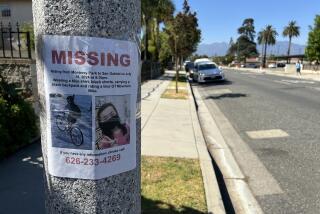Ventura Man Held in Girl’s Death Is Released : Courts: Authorities determine that he was not driving truck that caused fatal accident. Attention shifts to Oxnard resident.
- Share via
A drunk-driving murder case that already has raised questions about California Highway Patrol high-speed chase policies took an unexpected turn Friday when prosecutors admitted that they mistakenly had charged a passenger in the vehicle instead of the driver.
The criminal case against Antonio D. Morales, 21, of Ventura was dismissed after an examination of his injuries proved that he could not have been behind the wheel of the pickup truck that slammed into the back of a van and killed a 16-year-old girl, prosecutors said.
At the time of the accident, Morales was found to have a blood-alcohol level of 0.22%, nearly three times the legal limit.
Dist. Atty. Michael D. Bradbury said his office will now try to put a case together against the truck’s other occupant: Andres M. Seals, a legally blind Oxnard man without a driver’s license who has 20/400 vision in his one eye.
Seals will never face murder charges, however, since CHP officers did not determine his blood-alcohol level at the time of the Nov. 20 collision because they were convinced that he was the passenger, Bradbury said. Manslaughter charges against him are possible, Bradbury said.
In court Friday, Deputy Dist. Atty. Donald C. Glynn shook Morales’ hand and apologized for the error.
“I told him I was sorry that he spent four months in jail, and I’m glad we were able to establish his innocence and get him released,” Glynn said afterward.
Morales always insisted that he was the passenger, not the driver, in the pickup that two CHP officers chased for eight miles on the Ventura and Santa Paula freeways at speeds up to 100 m.p.h.
But despite obvious confusion at the scene of the nighttime accident--for example, the dead girl’s aunt and the aunt’s boyfriend were briefly held at gunpoint because the officers mistakenly believed that they might have caused the collision--both officers testified before a county grand jury that they were certain that Morales was the driver.
Officers Timothy Wilson and Brian Kennedy testified that they had seen two Latino men in the truck during the chase and that the driver had a hooded sweat shirt, the type of clothing Morales was wearing. Additionally, Kennedy testified that he found Morales in the middle of the front seat, almost on top of Seals, who was next to the passenger window as the truck leaned to the right.
Deputy Public Defender Richard E. Holly said he believes that the fatality following the high-speed chase put pressure on the officers “to come up with some suspect, any suspect,” because they didn’t want to go back to the station without one.
“Do I think they were lying--no,” Holly said. “But I think they made a mistake. It’s obvious they made a mistake. . . . They talked themselves into being certain.”
Holly said he was gathering his own evidence to try to prove that Morales was the passenger. In addition, Holly had called into question the CHP policy regarding high-speed chases, which he said contributed to the collision.
Bradbury said the mistake about who was driving was discovered after his office requested an analysis of the pickup truck and Morales’ injuries, particularly an oddly shaped cut in his forehead. Although CHP investigators initially believed that the injury came from Morales striking the steering wheel, it later was determined that the wound exactly matched a torn piece of vinyl on the passenger side of the dashboard.
Glynn also said Morales’ height would have made it impossible for his head to hit the steering wheel during the collision.
CHP Capt. Charles Campbell defended Wilson and Kennedy’s actions the night of the collision, saying they used “good professional judgment.” In a meeting earlier this week, however, after being shown the new evidence, the officers “had some doubts about what they had seen that night,” Campbell said.
Seals had testified before the grand jury that Morales was the driver. Glynn said he now hopes that Morales will be a witness against Seals.
Bradbury said Seals had perfect vision until he was injured in a traffic accident in February, 1992. The accident, in which his wife was killed, was not alcohol-related, Bradbury said.
The officers in the chase always said it involved several curious close calls with other vehicles. The driver stayed predominantly in the slow lane, racing up behind slower-moving cars and then swerving back into the fast lane at the last minute, the officers said.
Bradbury said Seals has peripheral vision in his one eye, but his legal blindness explains the erratic driving pattern. Holly agreed, noting that a person with just one eye has no depth perception, so Seals would not have known how close he was to any vehicle in front of him until the last minute.
More to Read
Sign up for Essential California
The most important California stories and recommendations in your inbox every morning.
You may occasionally receive promotional content from the Los Angeles Times.













